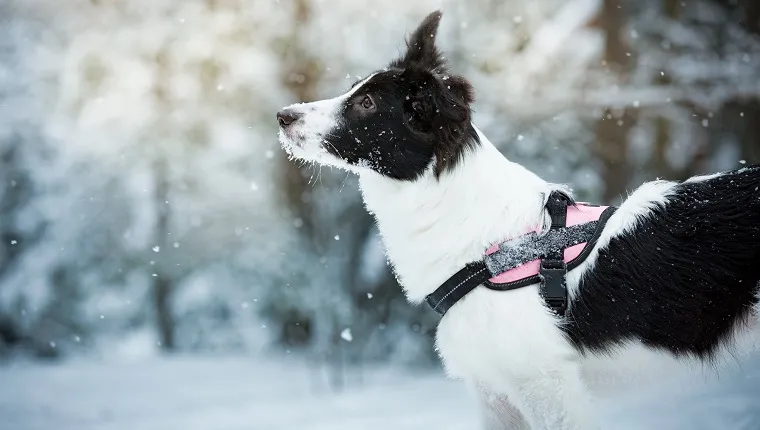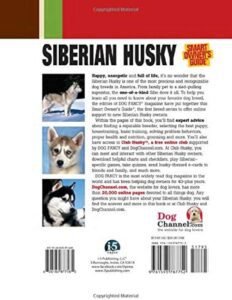Winter can be dangerous for dogs, but there are several myths that need to be debunked to ensure their safety. Contrary to popular belief, dogs and cats are not more resistant to cold weather because of their fur.
Just like people, they are susceptible to frostbite and hypothermia and should be kept indoors. Additionally, it is not safe for dogs to eat snow as it could contain waste, chemicals, and salt that are harmful to them. These dangerous myths need to be busted to protect our furry friends during the winter months.
(Words: 97)

Credit: www.facebook.com
Myth: Dogs Are More Resistant To Cold Weather
One dangerous myth about dogs and winter is that they are more resistant to cold weather due to their fur. However, dogs are susceptible to frostbite and hypothermia like humans and should be kept indoors to ensure their safety.
Fact: Dogs Are Susceptible To Frostbite And Hypothermia
Contrary to the myth that dogs are more resistant to cold weather, they are just as vulnerable to frostbite and hypothermia as humans. It is essential for pet owners to understand the risks involved and take necessary precautions to keep their furry friends safe during the winter months.Frostbite: A Real Danger For Dogs
Frostbite occurs when the skin and underlying tissues freeze due to prolonged exposure to extreme cold. Dogs’ ears, tail, paws, and nose are the most susceptible to frostbite. Look out for signs such as pale or discolored skin, swelling, and blisters. If you notice any of these symptoms, contact your veterinarian immediately for proper treatment.Hypothermia: More Common Than You Think
Hypothermia is a dangerous condition where a dog’s body temperature drops below the normal range. It can occur when dogs are exposed to cold temperatures for an extended period or when they get wet in freezing conditions. Watch out for symptoms like shivering, lethargy, weakness, and difficulty breathing. Swift action is crucial in such cases, so seek veterinary care promptly if you suspect your dog has hypothermia.Preventing Frostbite And Hypothermia In Dogs
To protect your beloved pooch from frostbite and hypothermia, follow these simple yet effective tips:- Limit outdoor time: Dogs should only spend a limited amount of time outside during freezing temperatures. Create a cozy indoor space for them to retreat to.
- Dress them up: Certain breeds with short coats or less body fat are more susceptible to the cold. Consider using doggy sweaters or jackets to provide extra insulation.
- Protect their paws: Snow, ice, and salt can be harsh on a dog’s paws. Use pet-safe ice melt on your walkways and consider using booties or paw balm to protect their paws from the cold and chemicals.
- Keep them dry: Moisture can accelerate the onset of frostbite and hypothermia. Dry your dog thoroughly after they come inside from wet conditions.
- Provide warmth: Ensure your dog has a warm and cozy bed or blanket to curl up in, away from drafts. Consider using a heated pet bed, but always follow the manufacturer’s instructions.

Credit: dogtime.com
Myth: Dogs Can Eat Snow
One dangerous myth about dogs and winter is that they can eat snow. In reality, it is not safe for dogs to consume snow due to potential contaminants like waste, chemicals, and salt. Additionally, eating snow can lower their core temperature and put them at risk of hypothermia.
One common myth about dogs and winter is that they can safely eat snow. Many dog owners allow their furry friends to snack on snowflakes thinking it’s a harmless indulgence. However, this belief couldn’t be further from the truth. In fact, allowing your dog to eat snow can be dangerous and potentially harmful. Let’s uncover the facts and bust this myth once and for all.
Fact: Snow Can Contain Waste, Chemicals, And Salt That Are Not Safe For Dogs
Contrary to popular belief, snow is not a clean and pure substance that is safe for dogs to consume. In reality, snowflakes can act as a blanket, covering up a host of hidden dangers. Beneath the beautiful white surface, there could be a smorgasbord of waste, chemicals, and salt that are not suitable for your dog’s delicate system.
When snow falls, it accumulates various pollutants from the environment, including contaminants from vehicles and industrial activities. These pollutants can pose serious risks to your dog’s health if ingested. Additionally, many municipalities and homeowners use salt and chemical deicers to melt snow and ice on sidewalks and driveways. These substances can also make their way into the snow, further jeopardizing your dog’s well-being.
Exposure to these harmful substances can lead to a range of issues for your dog. Ingesting snow contaminated with waste or chemicals can cause digestive problems, such as stomach upset and diarrhea. The high salt content in snow can lead to dehydration and electrolyte imbalances. Salt ingestion can also be toxic to dogs, potentially resulting in sodium poisoning.
To keep your dog safe during winter:
- Avoid letting your dog eat snow altogether.
- Keep an eye on your surroundings when walking your dog to avoid areas with salt or chemical deicers.
- After your walk, wipe your dog’s paws with a warm, damp cloth to remove any potential contaminants.
- Always provide your dog with fresh water to prevent dehydration.
By debunking the myth that dogs can eat snow, you can ensure the safety and well-being of your furry companion throughout the winter season. Remember, it’s always better to be cautious and prioritizing your dog’s health over indulging in popular misconceptions.
Myth: Dogs Don’t Need Protection From The Cold
One dangerous myth about dogs and winter that we need to bust is that dogs don’t need protection from the cold. Contrary to popular belief, dogs are susceptible to frostbite and hypothermia, just like humans, and should be kept indoors during cold weather.
Don’t risk your furry friend’s health, keep them warm and safe.
Fact: Dogs With Thick Coats Are More Cold-tolerant, But Still Require Precautions
When it comes to protecting our furry friends during the winter months, there is a dangerous myth that often circulates – dogs with thick coats don’t need any extra protection from the cold. While it is true that dogs with thick fur have a built-in insulation system, it doesn’t mean they are impervious to freezing temperatures. In fact, dogs with thick coats are more cold-tolerant than those with shorter fur, but they still require precautions to ensure their safety and well-being. Here are some important facts to consider:Dogs Can Still Suffer From Hypothermia And Frostbite
Despite their natural fur coat, dogs can still be at risk of developing hypothermia and frostbite in extreme cold temperatures. Just like humans, their extremities, such as their paws and ears, are more susceptible to frostbite. Additionally, if their body temperature drops too low, it can lead to hypothermia, which can be life-threatening.Providing Shelter And Warmth Is Crucial
Even if your dog has a thick coat, it is essential to provide them with shelter and warmth during the winter months. This means ensuring they have a warm and dry place to retreat to, such as a cozy dog house or a designated area inside your home. Consider providing them with extra blankets or a heated pet bed to help regulate their body temperature.Limit Outdoor Exposure And Monitor For Signs Of Discomfort
While it’s important to allow your dog some outdoor time for exercise and bathroom breaks, it’s crucial to limit their exposure to cold weather. Dogs should not be left outside for extended periods in freezing temperatures, as it can be detrimental to their health. Always monitor your dog for signs of discomfort, such as shivering or lifting their paws, and bring them indoors if necessary.Protective Clothing Can Be Beneficial
In addition to providing shelter and warmth, protective clothing can be beneficial for dogs during the winter months. Consider investing in a doggy sweater or jacket, especially for dogs with shorter fur or those that are more sensitive to the cold. These garments can help provide an extra layer of insulation and can be particularly helpful during walks or outdoor activities. In conclusion, while dogs with thick coats may have a higher tolerance for cold weather, it is still essential to take precautions and provide them with the necessary protection during the winter months. By understanding and debunking this dangerous myth, we can ensure the safety and well-being of our beloved canine companions.
Credit: www.pinterest.com
Myth: Dogs Need More Water In Winter
Contrary to popular myth, dogs do not need more water in winter. While dogs may drink more after exercising, their water intake should remain consistent throughout the year.
One common misconception about dogs and winter is that they need to drink more water. However, the truth is that winter weather doesn’t necessarily increase a dog’s water intake. While it’s important to ensure that your dog stays hydrated at all times, it’s not specifically related to the season.
Factors such as exercise, diet, and overall health play a much bigger role in determining a dog’s water needs. It’s essential to provide your furry friend with access to clean water, regardless of the time of year. Monitoring their water intake and ensuring they have enough to drink throughout the day is crucial for their well-being.
Fact: Winter weather doesn’t necessarily increase a dog’s water intake.
While it can be tempting to think that dogs need more water in winter due to the dry, cold air, this is not scientifically proven. In fact, some dogs may even drink less water during winter due to decreased physical activity. It’s important to observe your dog’s behavior and provide water accordingly.
Remember that staying hydrated is essential for a dog’s overall health and well-being. Here are some tips to ensure your dog gets enough water during winter:
- Ensure your dog’s water bowl is always clean and filled with fresh water.
- Monitor your dog’s water consumption and refill the bowl when necessary.
- Consider adding wet food or broths to their diet to increase moisture intake.
- Offer ice cubes or frozen treats as a fun and refreshing way for your dog to stay hydrated.
By debunking this myth, dog owners can now focus on providing the right amount of water to their furry companions irrespective of the season. Remember, a well-hydrated dog is a healthy dog!
Myth: Dogs Don’t Need A Sweater
One of the most common myths about dogs and winter is that they don’t need a sweater. Many people believe that because dogs have fur, they have a built-in protection against the cold weather. However, this is not always the case, especially for smaller or short-haired breeds. So, let’s bust this myth and explore the facts about dogs and sweaters in cold weather.
Fact: Some Dogs, Especially Smaller Or Short-haired Breeds, May Benefit From Wearing A Sweater In Cold Weather
In cold weather, it’s important to remember that not all dogs are created equal when it comes to handling the cold. While some breeds are naturally more resistant to low temperatures, others may struggle to stay warm. This is particularly true for smaller or short-haired breeds, whose fur may not provide enough insulation against the cold.
While it’s true that dogs have a higher body temperature than humans and have a natural ability to regulate their body temperature, extreme cold can still be dangerous for them. Just like humans, dogs can experience frostbite and hypothermia if exposed to freezing temperatures for prolonged periods.
That’s where dog sweaters come in. By providing an additional layer of warmth, sweaters can help dogs retain their body heat and protect them from the harsh winter weather.
Here are a few reasons why some dogs may benefit from wearing a sweater in cold weather:
- Smaller breeds and short-haired dogs have less natural insulation against the cold. A sweater can help them stay warm and comfortable.
- Elderly dogs or those with certain health conditions may have a harder time regulating their body temperature. A sweater can provide them with the extra warmth they need.
- Dogs that are recovering from an illness or surgery may have a weakened immune system and may be more susceptible to the cold. A sweater can help protect them during their recovery.
In addition to keeping them warm, dog sweaters can also be fashionable. They come in a variety of styles and colors, allowing you to dress up your furry friend and make them look adorable while keeping them cozy.
When choosing a dog sweater, it’s important to consider the size and breed of your dog. Ensure that the sweater fits well and does not restrict their movement or breathing. It should be snug enough to provide warmth but not too tight to cause discomfort.
If you live in an area with extremely cold temperatures, it’s also a good idea to consider other protective gear for your dog, such as boots to protect their paws from ice and salt. Remember, just like us, dogs deserve to be comfortable and safe during the winter season.
Frequently Asked Questions For 7 Dangerous Myths About Dogs And Winter That We Need To Bust
Is Winter Bad For Dogs?
Winter is not good for dogs. Contrary to popular belief, dogs are susceptible to frostbite and hypothermia like humans. It is important to keep them indoors during cold weather.
How Do Dogs React To Winter?
Dogs are not more resistant to cold weather than humans. They can get frostbite and hypothermia, so it’s best to keep them indoors during winter.
How Can Dogs Survive In The Winter?
Dogs can survive in winter due to their natural fur coat, especially those with thick, double-layered coats like Siberian Huskies. These breeds originated in colder climates and have adapted to thrive in low temperatures. However, it’s still important to keep dogs indoors during extreme cold weather to prevent frostbite and hypothermia.
Is It Good For Dogs To Snow?
Contrary to popular belief, it is not safe for dogs to eat snow. Snow can contain waste, chemicals, and salt that are not suitable for ingestion, and it can lower the dog’s core temperature, risking hypothermia. It is best to keep dogs away from snow.
Conclusion
In order to keep our furry friends safe during the winter months, it’s essential to debunk the dangerous myths surrounding dogs and winter. Contrary to popular belief, dogs are not resistant to cold weather just because of their fur. They are just as susceptible to frostbite and hypothermia as humans.
It’s important to keep them inside and provide them with the necessary protection. Remember, not everything you read online is true, so let’s bust these myths and ensure our dogs stay safe and healthy during the winter season.







